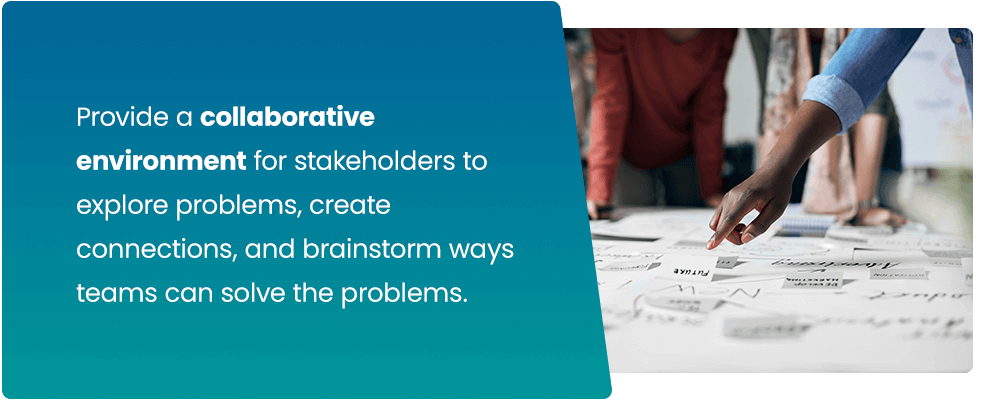Strategic planning is a must for successful companies. Traditionally, members of executive leadership gather to create goals each year. They consider the previous year’s performance while making key initiatives and objectives to suit shareholder expectations.
Instead of facilitating strategic planning through this method called top-down planning, there’s a better alternative. Cross-functional collaboration and planning include the perspectives of leaders, managers, employees and shareholders.
When well-structured, involving more perspectives offers many benefits. Learn how to tackle any challenge your organization needs to solve when implementing strategic collaboration at your business.
In This Article
- What Is Collaboration in Strategic Planning and Why Is It Important?
- 6 Ways to Increase Collaboration in Strategic Planning
- Consider and Involve all Relevant Stakeholders and Departments for Business Initiatives
- Create a Steering Committee with Cross-Functional Representation
- Encourage Regular Collaboration Between Departments in a Structured Environment
- Establish Periodic Review Sessions for Departments to Meet and Discuss Progress and Impediments
- Create a System for Shared Resource Allocation on Shared Initiatives
- Create a Shared Deliverable Calendar to Ensure Timely Execution of Initiatives
- Increase Collaboration in Strategic Planning With AchieveIt
- Ready to Improve Your Plan Execution?
What Is Collaboration in Strategic Planning and Why Is It Important?
Implementing a workplace method requires getting everyone involved on board with an idea. A collaborative strategy can make for a smoother transition and more effective results when you plan to add or change a procedure. It offers the following benefits:
- Inclusion: Collaborative planning refers to hearing from all levels of your organization during the brainstorming stages of a change or development. Throughout this process, those most affected by future decisions can feel heard. Their input can put into perspective what makes the most sense when choosing how to improve their daily activities and routines.
- Open communication: Inviting everyone to the soundboard takes courage. Leaders must level the playing field to create an environment where open communication can flourish. When employees feel like their thoughts are valued, you’ll witness innovative ideas and solutions emerge.
- Better chance of stakeholder approval: In classic structures, stakeholders usually need to sign off on big decisions. Inviting your stakeholders to the brainstorming stages improves efficiency. You’ll already have stakeholder thoughts and expertise in the conversation, giving you valuable insight into which plans would or wouldn’t get approved.
- Streamlined action to implement plans: When a collaborative plan is approved, your company will face fewer obstacles. You’ll have confidence knowing those who would’ve objected to the idea had an opportunity to step in and offer their alternatives. Enjoy moving forward with your employee’s acceptance and willingness to take action when they feel included in all processes, from inspiration to implementation.
6 Ways to Increase Collaboration in Strategic Planning
Whether you want to brainstorm new products or improve customer experiences, you’ll only know who has the best idea for reaching your goals once you open the conversation to everyone. Allow your company’s success to soar when you increase collaboration using these tips.
1. Consider and Involve all Relevant Stakeholders and Departments for Business Initiatives
Imagine one of your key business initiatives is to reduce customer churn by 10%. With the “what” identified, the next step is to determine the “how”. How will we reduce churn by 10%? What actions will we take to impact this number?
When planning the “how”, first include all the stakeholders. In this example, include the departments that interface with the customer from on-boarding through renewal.
Who all contributed?
Well, marketing may have originated the lead and set expectations through marketing messaging. The Sales team worked to understand the customer challenges and provide a solution. The Customer Success team managed onboarding and ongoing support to delight the customer. And lastly, Finance handled any billing and collection needs.
By bringing in all stakeholders who act as touchpoints for customers, an organization can consider all possible opportunities for process improvement to reduce churn. Is the issue in inconsistent expectations from sales to customer teams? Is it misalignment from marketing messaging? Or is it something in the implementation process?
Only through leveraging cross-functional collaboration can one understand the connection points between problems. With the understanding in place, a solution can be identified.
This model applies to most initiatives. Involve all stakeholders who are directly and indirectly involved for a 360-degree perspective.
2. Create a Steering Committee with Cross-Functional Representation
With the goal of including all stakeholders, what now? How do you ensure the right people are involved and that it’s not a chore to gather the needed people?
Establish a steering committee to promote discussion around key issues experienced in each department.
Provide a collaborative environment for stakeholders to explore problems, create connections between problems, and brainstorm ways teams can collaborate to solve the problems. This ensures that agreed-upon initiatives have the broadest impact across the organization.
Select leaders from each department and work to involve stakeholders across all levels of the organization for the most rounded perspective.

3. Encourage Regular Collaboration Between Departments in a Structured Environment
Establishing regular meetings and communication between stakeholders across departments is the best way to root out impediments to success in a timely manner.
While having organizational representation during planning is important, it shouldn’t stop there.
Encourage members of the steering committee to regularly discuss key business issues by scheduling bi-weekly or monthly review meetings.
Between meetings, establish a system for communication that allows for ad-hoc planning and collaboration around business issues in real-time.
FREE RESOURCE
4 Stages to Create a Culture of Execution
Download this guide to learn how to build an organizational culture that amplifies execution and results.

4. Establish Periodic Review Sessions for Departments to Meet and Discuss Progress and Impediments
While cross-functional meetings are important, don’t forget about inter-department communication.
If they aren’t happening already, establish regular departmental meetings to discuss progress on key initiatives. Consider a cadence to occasionally include company leadership and the steering committee as observers.
These meetings should discuss departmental issues and allow for complete transparency into operations. Long-term, this helps encourage a culture of continuous improvement.
5. Create a System for Shared Resource Allocation on Shared Initiatives
It is common for departmental managers to blame lack of resources or budget constraints. Why did we miss our target? Well, not enough resources of course.
As discussed in the example to reduce customer churn by 10%, at least four departments are involved in successfully attaining this metric. As necessary, these four departments should share resources, time, and energy to ensure success.
Encouraging shared resource allocation gives every department skin in the game while increasing the number of resources available for success.

6. Create a Shared Deliverable Calendar to Ensure Timely Execution of Initiatives
Steps 1-5 helped to establish systems for cross-functional teams to meet, share resources, and outline key shared initiatives.
The final step is to promote transparency to encourage timely execution.
Create a shared deliverable, or dashboard, that outlines key objectives and tasks, due dates, and accountable parties. This ensures that teams across the organization know what needs to be done, by when, and by whom.
This sense of shared success across the organization creates a culture of cross-functional accountability. A culture that translates well when entering your next planning cycle.
Increase Collaboration in Strategic Planning With AchieveIt
AchieveIt is the platform that large organizations use to get their biggest, most important initiatives out of the boardroom and into reality. Too many great ideas never quite make it across the finish line, because there’s no real way to keep everyone on course and keep everything on track. What does it take to actually guide these initiatives all the way through to completion?
Our company offers the answers and solutions you need:
- More awareness: A user-friendly platform gives you access to real-time data and information at every level of your organization.
- Better engagement: The digital space offers a way to connect while staying on the same page and increasing employee engagement in your strategic plans.
- Increased accountability: A collection of accurate metrics can identify how far along your company is progressing to reach an intended goal by a deadline.
- Exclusive insight from experts: The execution experts at AchieveIt provide the guidance you need to incorporate this platform into your everyday use in a smooth, effective way.
That’s why everyone from global corporations, to regional healthcare systems, to federal agencies have turned to AchieveIt for their Integrated Plan Management. Let’s do this.
Ready to improve your plan execution?
Organizations of all types leverage AchieveIt to manage, execute, and connect their most important initiatives. Replace manual processes & siloed systems with interconnected plans in a single, automated platform.



